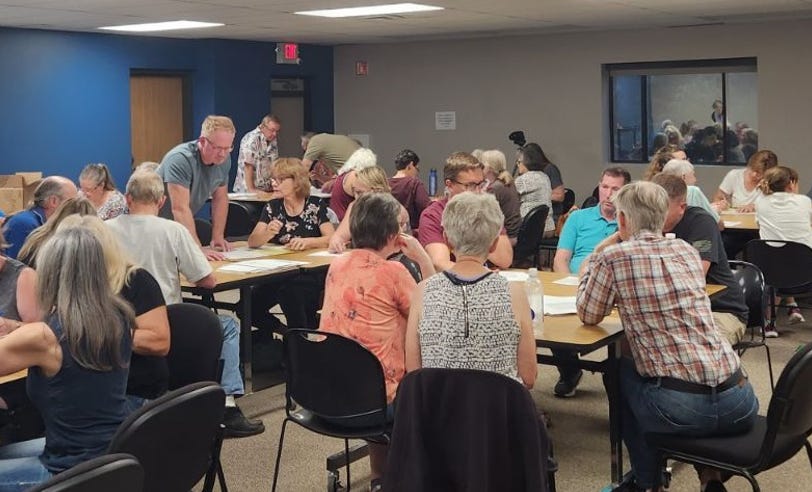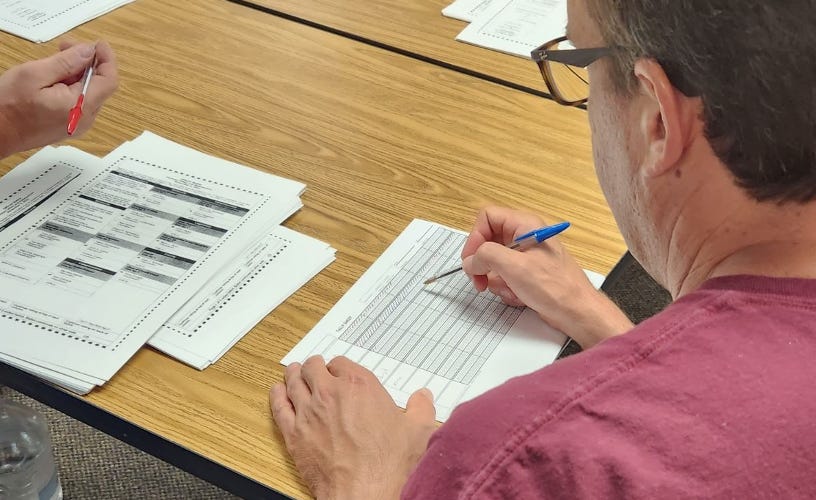Draft of "Hand Counts in America"
On July 13, 2023 I participated in my first ever hand count in Big Lake, Minnesota. It was the third hand count studies done by Rick Weible. Rick had bought ballot stock from SeaChange and printed 3,000 of Dodge County, Wisoconsin’s ballot images from the cast vote record information published on their county website. It was fun! I was one of the callers for a bit while two talliers tallied on my left and right. It made me believe that we can and will be able to do this, everywhere.
There are a few hand count guides out there, like this longer one, or like this one recalling 1982 elections in Texas, but wanted to get started on a very brief one that is easy to print off and pass around. This way everyone can learn, practice, and prepare their local areas.
As for the guide, everyone should feel free and welcome to take this and build on it. If you see something to improve, simply make a comment or reply to this email. Please don’t hold back. Could be anything from a typo to a title suggestion to a major structural change. This is a chance to make it easy for everyone to get excited about this and actually grow the momentum to make it happen—your simple question or addition could make a big difference.
After a few weeks with additional drafts, together we’ll have something quite good to begin making look very good design-wise to then print and pass around to anyone interested in helping this cause.
Before reading the draft below, if you want to support more hand count studies by Rick Weible, go to https://uscase.org or donate directly here.
Hand Counts in America
by We the People
Background
In recent years, Americans in every state, in every county, have learned more about how elections work.
Americans in every state, in every county, want elections that can be trusted.
Americans in every state, in every county, also want elections that are auditable.
Under current laws and process, most elections are not truly auditable, and therefore are not widely trusted.
Hand counts are one way to ensure the tabulation or tallying of votes can be trusted.
It should be remembered that counting votes manually, by human hand and eye and tally sheet, does not clean voter rolls nor does it verify whether a ballot was cast by a legal American voter. So, separate to this guide, voter rolls not only need to be clean and accurate but verifiably so, and the chain of custody that is broken by mail-in ballots needs to be addressed. But those two areas are not the focus of this guide.
This guide provides a simple framework for hand counting. While many in the past have hand counted and some counties sprinkled throughout America still do, there is not a widely known method to encourage uptake.
Why Hand Counts?
Hand counts are one way to ensure the tabulation or tallying of votes can be trusted.
Hand counts have been shown to have a high level of accuracy and speed (LINK TO STATS). They are also very cost effective, especially if election judges or counters waive the wages for their service (LINK TO STATS), which is quite likely to be a high number considering the number of citizens who have spent many hours volunteering their time the last three years studying how elections work.
Studies done by USCASE in South Dakota Minnesota demonstrated hand counts are more accurate than machine counts. For instance, the human eye notices where the machine has counted a fold in the paper incorrectly as an over-vote. (INSERT IMAGE OF FOLDED BALLOT compared to CAST VOTE RECORD.)
How to Approach Hand Counting
This section helps to prepare for election day and then walks through the election day process.
Prepare for election day
Answer these questions:
- How many precincts (polling locations) are there in your county?
- How many races will be on the ballot?
- How many candidates per race?
These questions give you the “demand” or the number of votes to count, which helps the “supply” of volunteers or paid counters required to effectively hand count the election at each each precinct. An example of these calculations is available here (LINK TO EXAMPLE).
Election day
A beautiful day!
After everyone has happily voted, it is time to count the votes. (Check your state statute to understand when counting can being.)
Then, consider the following method.

- Work in groups of 3-4 people, depending on total number of counters.
- Sort ballots into stacks of a certain number. (In Minnesota, the state hand counting guideline is 25 ballots per stack - see pg 50 of this guide.)
- Two of the three people will tally, each with their own tally sheet. (Video showing tally sheet.)
- The third person is the caller. This person will read the name of the candidate who was voted for on that race on each ballot. As ballots are read, the talliers can verify the caller is saying the correct name and then make a tally on their tally sheet.
- Continue until the stack is complete. Do not move onto the next stack until the talliers verify they have the same tally. If there is a discrepancy, such as candidate A having 13 votes for counter 1 while candidate A has 14 votes for counter 2, the stack of ballots must be recounted. (INSERT IMAGE SHOWING EXAMPLE)
- Move onto the next stack, and so on, until all ballots are completed for the particular race.
- If there are multiple groups, then the totals from each group should be summed (added together) on a final tally sheet for a race.
- Once the first race on the ballot is completed, a short break of a few minutes can be taken to stretch and congratulate one another.
- Then work can continue on the next race on the ballot.

Post Election
Hand counting can be used as the primary method or as a secondary method next to a machine or electronic tabulator (in which case the hand count serves as an immediate audit—though does not guarantee chain of custody or legitimacy of ballots). But be aware that this guide recommends against using electronic voting equipment of any kind.
For counties or even precincts within a county that opt for hand counting only, there will be no risk of a machine failing to accurately count.
In addition, because of the increased number of citizens who were involved in the process versus the current process, there is likely to be more trust in the election results in counties that choose this approach.
Results at the precinct level can be published or posted as soon as counting is complete. If an entire state hand counts, then citizens can simply add up the results from every precinct (polling location) which has posted results to arrive at the totals for each race, instead of waiting for multiple digital handoffs to aggregate the unofficial results.
Member discussion